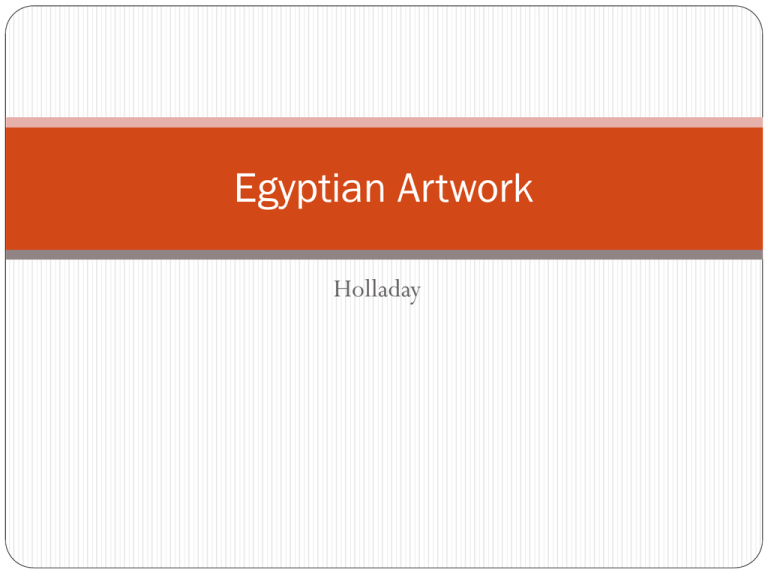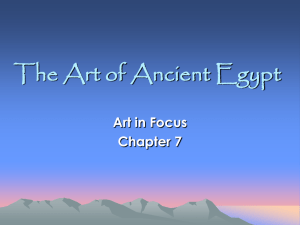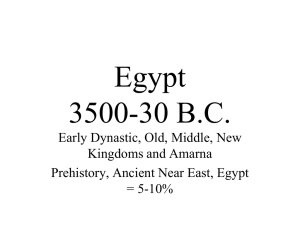Egypt Artwork
advertisement

Egyptian Artwork Holladay Artwork… for their religion! Architecture/Pyramids The Figure; 18/20 grid pyramid, frontal facing/ awkward positions Paintings Reliefs/ Sculpture Language= Hieroglyphics History of Kingdoms Old - Went from mastabas to pyramids, used mudbrick, first pyramid was for King Djosers (looked like ziggurat) - Pyramids of Giza - End of “grand pyramids” Middle -split into competing states - Rich/privilaged could have elaborate tombs for themselves - Began carving tombs into cliffs - Increase in trade + increase middle class = increase demands - Hyksos conquered lower egypt. New - Egypt expanded into an empire (Nubia and Libya) - No pyramids, mostly rock tombs - Artwork moved to more naturalistic - Queen Hepshepsut = increase in peace (only had 4 queens in 3,000 year reign) Leaving the New Kingdom - Moved toward monotheistic because of Amun Hotep IV, 18th dynasty = increase humanity - Open air temples, natural setting - “honesty” depicted pharaoh truthfully - King Tut Iconography.. Just a few. Lotus Flower; resurrection Hippopotamus; female - hippopotamus, as a goddess of maternity and a protector or women in childbirth, male hippo as the embodiment of all that was dangerous and wild Gods Horus (sky god, hawk head) Amun (god of creation) Ra (sun god or soul) Anubis (death, jackal) Upper Egypt, bowling pin crown, lotus and vulture Lower Egypt, red hatchet crown, papyrus Hippopotamus Ankh (symbol of life) Eye of Horus, protection and royal power Portrait of a Boy, 2nd century C.E.; Roman period Egyptian Architecture/Pyramids Burial tombs Lotus Collumns Sphinx Old Kingdom http://www.nationalgeographic.com/pyramids/pyramids.html Kinds of Pyramids Pyramid: a special type of polyhedron (a polyhedron is a solid figure with flat faces that are polygons)in which all of the faces, except possibly the base, are triangles that meet in a common point called the vertex. The base is always a polygon (a polygon is a closed figure with 3 or more sides) but not always a triangle. There are three main kinds of pyramids: the Step Pyramid, which has six steps; the Bent Pyramid (only one was made, and that was for Pharaoh Sneferu), and the Straight-sided Pyramid (also known as the True Pyramid, which is also the most common). The Great Sphinx of Giza with Khafre's pyramid in the background. Fourth dynasty, Old Kingdom The Temple of Dendur, ca. 15 B.C.E.; Roman period Egyptian; Nubia, Dendur temple of ramses ii, abu simbel (67 years, 19th dynasty, 65 ft tall statues, used art as political propoganda) The Figure Paintings Very symbolic; religiously based Paintings of afterlife Book of the Dead; allowed anyone to be resurrected (old kingdom= murals, new kingdom = on papyrus scrolls), included spells, charms, passwords, prayers.. Individualized to owner http://historylink101.net/egypt_1/pic_wall_paintings_1.h tm Ostracon, ca. 1295–?1069 B.C.E.; Dynasties 19–20; New Kingdom Egyptian; Thebes Section from the "Book of the Dead" of Nany, ca. 1040–945 B.C.E.; Dynasty 21, reigns of Psensennes I–II; Third Intermediate period Egyptian; Western Thebes Relief of Nebhepetre Mentuhotep, ca. 2040–2010 B.C.E.; reign of Nebhepetre Mentuhotep; Middle Kingdom Egyptian; Upper Egypt, Western Thebes Tombs Covered in heirogphic spells Common images; gods protecting the pharoahs deceased, afterlife Ushabtis = mummy slaves to protect Pharoahs buried with everything.. Like food, carriages, animals, Coffin of Khnum-nakht, ca. 1900–1800 B.C.E.; Dynasty 12; Middle Kingdom Egyptian; Possibly from Asyut Outer Coffin of Henettawy, ca. 1040–991 B.C.E.; Dynasty 21; Third Intermediate period Egyptian; Thebes Pottery Bowl with Human Feet, ca. 3750–3550 B.C.E.; possibly late Naqada I–early Naqada II; Predynastic period Reliefs/ Sculpture Scarab of Wah, ca. 1990–1985 B.C.E.; early Dynasty 12; Middle Kingdom Egyptian; Western Thebes Statue of an Offering Bearer, ca. 1985 B.C.E.; Dynasty 12, early reign of Amenemhat I; Middle Kingdom Egyptian; Western Thebes Statue of Demedji and Hennutsen, ca. 2465–26 B.C.E.; early Dynasty 5; Old Kingdom Egyptian Ritual Figure, ca. 1929–1878 B.C.E.; Dynasty 12, reigns of Amenemhat II–Senwosret II; Middle Kingdom Egyptian; Lisht Stela of Mentuwoser, ca. 1955 B.C.E.; Dynasty 12, reign of Senwosret I, year 17; Middle Kingdom Egyptian; Probably from Abydos Statuette of Amun, ca. 945–715 B.C.E.; Dynasty 22; late Dynastic period Egyptian Ram's-Head Amulet, ca. 770–657 B.C.E.; Dynasty 25; late Dynastic period Egyptian Statuette of a Woman, 664–525 B.C.E.; Dynasty 26; late Dynastic period Egyptian The God Horus Protecting King Nectanebo II, 360–343 B.C.E.; Dynasty 30, reign of Nectanebo II; late period Egyptian Cat, 330–30 B.C.E.; Ptolemaic period Egyptian Sphinx of Senwosret III, ca. 1878–1841 B.C.E.; Dynasty 12, reign of Senwosret III; Middle Kingdom Egyptian Pectoral with the Name of Senwosret II, ca. 1897–1878 B.C.E.; Dynasty 12, reigns of Senwosret II– Amenemhat III; Middle Kingdom Egyptian; Lahun Statuette of a Hippopotamus, ca. 1981-1885 B.C.E.; Dynasty 12; Middle Kingdom Egyptian; Middle Egypt, Meir Kneeling Statue of Tuthmosis III, 1479–25 B.C.E.; Dynasty 18, reign of Tuthmosis III; New Kingdom Egyptian Sphinx of Amenhotep III 1391-1353BCE 18th dynasty New Kingdom Egypt Canopic Jar with a Lid in the Shape of a Royal Woman's Head , ca. 1349–1336 B.C.E. or shortly after; Dynasty 18, late reign of Akhenaten; New Kingdom Egyptian; Western Thebes Language Cartouche; oblong enclosure with a horizontal line at one end, indicating that the text enclosed is a royal name Heiroglychics, picture language Rosetta Stone: translator from egyptian to greek.. Used Coptic The ‘in between language’ that crossed Phonetic sounds of egypt to greek At British Museum Works Cited http://www.google.com/imgres?imgurl=http://mathildasa nthropologyblog.files.wordpress.com/2008/11/mastabaok.j http://en.wikipedia.org/wiki/File:GD-EG-Karnak040.JPG





